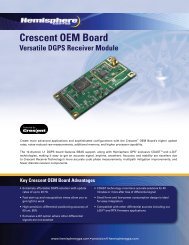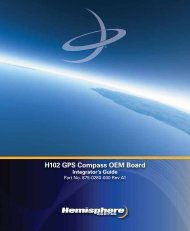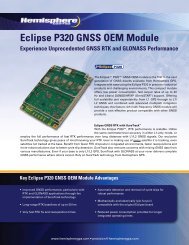SBX-4 Integrator Guide
SBX-4 Integrator Guide
SBX-4 Integrator Guide
You also want an ePaper? Increase the reach of your titles
YUMPU automatically turns print PDFs into web optimized ePapers that Google loves.
<strong>SBX</strong>-4<br />
<strong>Integrator</strong> <strong>Guide</strong><br />
Part No. 875-0176-000 Rev. B1
This device complies with Part 15 of the FCC rules. Operation is subject to the following<br />
two conditions:<br />
• This device may not cause harmful interference.<br />
• This device must accept any interference received, including interference that may<br />
cause undesired operation.<br />
COPYRIGHT NOTICE<br />
Hemisphere GPS Inc. Precision GPS Applications<br />
© Copyright Hemisphere GPS Inc. (2007). All rights reserved.<br />
No part of this manual may be reproduced, transmitted, transcribed, stored in a retrieval<br />
system or translated into any language or computer language, in any form or by any<br />
means, electronic, mechanical, magnetic, optical, chemical, manual or otherwise, without<br />
the prior written permission of Hemisphere GPS Inc.<br />
TRADEMARKS<br />
Hemisphere GPS and the Hemisphere GPS logo, Satloc and the Satloc logo, Mapstar, Air<br />
Star Outback Guidance and eDrive are trademarks of Hemisphere GPS. Other trademarks<br />
are the properties of their respective owners.<br />
NOTICE TO CUSTOMERS<br />
Contact your local dealer for technical assistance. To find the authorized dealer near you,<br />
call or write us at:<br />
Hemisphere GPS Inc.<br />
4110 9 Street S.E. Telephone number: (403) 259-3311<br />
Calgary, AB, Canada Fax number: (403) 259-8866<br />
T2G 3C4 E-mail address: sales@hemispheregps.com
Warranty Notice<br />
COVERED PRODUCTS<br />
This warranty covers all products manufactured by Hemisphere GPS Inc. (the<br />
"Products").<br />
HEMISPHERE GPS INC. LIMITED WARRANTY<br />
Hemisphere GPS Inc. hereby warrants solely to the end purchaser of the Products,<br />
subject to the exclusions and procedures set forth herein below, that the Products sold to<br />
such end purchaser shall be free, under normal use and maintenance, from defects in<br />
material and workmanship for a period of 12 months from delivery to such end purchaser.<br />
Repairs and replacement components are warranted, subject to the exclusions and<br />
procedures set forth below, to be free, under normal use and maintenance, from defects<br />
in material and workmanship for 90 days from performance or delivery, or for the balance<br />
of the original warranty period, whichever is greater.<br />
PURCHASER'S EXCLUSIVE REMEDY<br />
The end purchaser's exclusive remedy under this warranty shall be limited to the repair or<br />
replacement, at the option of Hemisphere GPS, of any defective Products or components<br />
thereof. The end user shall notify Hemisphere GPS or a Hemisphere GPS approved service<br />
center immediately of any claimed defect. Repairs shall be made through a Hemisphere<br />
GPS approved service center only.<br />
EXCLUSIONS<br />
Hemisphere GPS does not warrant damage occurring in transit or due to misuse, abuse,<br />
improper installation, neglect, lightning (or other electrical discharge) or fresh/salt water<br />
immersion of Products. Repair, modification or service of Hemisphere GPS products by<br />
any party other than a Hemisphere GPS approved service center shall render this<br />
warranty null and void. Hemisphere GPS does not warrant claims asserted after the end<br />
of the warranty period. Hemisphere GPS does not warrant or guarantee the precision or<br />
accuracy of positions obtained when using Products. Products are not intended for<br />
primary navigation or for use in safety of life applications. The potential accuracy of<br />
Products as stated in Hemisphere GPS literature and/or Product specifications serves to<br />
provide only an estimate of achievable accuracy based on:<br />
• Specifications provided by the US Department of Defense for GPS Positioning,<br />
• DGPS service provider performance specifications.<br />
Hemisphere GPS reserves the right to modify Products without any obligation to notify,<br />
supply or install any improvements or alterations to existing Products.
NO OTHER WARRANTIES<br />
THE FOREGOING WARRANTY IS EXCLUSIVE OF ALL OTHER WARRANTIES, WHETHER<br />
WRITTEN, ORAL, IMPLIED OR ARISING BY STATUTE, COURSE OF DEALING OR TRADE<br />
USAGE, IN CONNECTION WITH THE DESIGN, SALE, INSTALLATION, SERVICE OR USE OF<br />
ANY PRODUCTS OR ANY COMPONENTS THEREOF, INCLUDING, BUT NOT LIMITED TO,<br />
ANY WARRANTY OF MERCHANTABILITY OR FITNESS FOR A PARTICULAR PURPOSE.<br />
LIMITATION OF LIABILITY<br />
THE EXTENT OF HEMISPHERE GPS' LIABILITY FOR DAMAGES OF ANY NATURE TO THE<br />
END PURCHASER OR ANY OTHER PERSON OR ENTITY WHETHER IN CONTRACT OR TORT<br />
AND WHETHER TO PERSONS OR PROPERTY SHALL IN NO CASE EXCEED, IN THE<br />
AGGREGATE, THE COST OF CORRECTING THE DEFECT IN THE PRODUCT OR, AT<br />
HEMISPHERE GPS' OPTION, THE COST OF REPLACING THE DEFECTIVE ITEM. IN NO<br />
EVENT WILL HEMISPHERE GPS BE LIABLE FOR ANY LOSS OF PRODUCTION, LOSS OF<br />
PROFITS, LOSS OF USE OR FOR ANY SPECIAL, INDIRECT, INCIDENTAL, CONSEQUENTIAL<br />
OR CONTINGENT DAMAGES, EVEN IF HEMISPHERE GPS HAS BEEN ADVISED OF THE<br />
POSSIBILITY OF SUCH DAMAGES. WITHOUT LIMITING THE FOREGOING, HEMISPHERE<br />
GPS SHALL NOT BE LIABLE FOR ANY DAMAGES OF ANY KIND RESULTING FROM<br />
INSTALLATION, USE, QUALITY, PERFORMANCE OR ACCURACY OF ANY PRODUCTS.<br />
GOVERNING LEGISLATION<br />
To the greatest extent possible, this warranty shall be governed by the laws of the State<br />
of Arizona. In the event that any provision hereof is held to be invalid by a court of<br />
competent jurisdiction, such provision shall be severed from this warranty and the<br />
remaining provisions shall remain in full force and effect.<br />
OBTAINING WARRANTY SERVICE<br />
In order to obtain warranty service, the end purchaser must bring the Product to a<br />
Hemisphere GPS approved service center along with the end purchaser's proof of<br />
purchase. For any questions regarding warranty service or to obtain information<br />
regarding the location of any of Hemisphere GPS' approved service centers, contact<br />
Hemisphere GPS at the following address:<br />
Hemisphere GPS Inc.<br />
7560 East Redfield Road, Suite B<br />
Scottsdale, Arizona 85260<br />
Phone 480.348.9919 Fax 480.348.6370<br />
techsupport@hemisphergps.com<br />
http://www.hemispheregps.com
<strong>SBX</strong>-4 <strong>Integrator</strong> Manual<br />
Table of Contents<br />
OVERVIEW . . . . . . . . . . . . . . . . . .1<br />
Overview . . . . . . . . . . . . . . . . . . . . . . . . . . . . . . . . . . . . 2<br />
1: INTEGRATION . . . . . . . . . . . . .5<br />
Mechanical Layout . . . . . . . . . . . . . . . . . . . . . . . . . . . . . 6<br />
LED Indicators . . . . . . . . . . . . . . . . . . . . . . . . . . . . . . . . 9<br />
<strong>SBX</strong>-4 Block Diagram . . . . . . . . . . . . . . . . . . . . . . . . . 10<br />
<strong>SBX</strong>-4 Connector Pin Assignments . . . . . . . . . . . . . . . 11<br />
Signal Lock Indicator Pin . . . . . . . . . . . . . . . . . . . . . . 13<br />
Reset Pin . . . . . . . . . . . . . . . . . . . . . . . . . . . . . . . . . . . 14<br />
Antenna Interface . . . . . . . . . . . . . . . . . . . . . . . . . . . . 15<br />
Radio Frequency Immunity and Emissions . . . . . . . . . 16<br />
<strong>SBX</strong>-4 Dual Serial Port Overview . . . . . . . . . . . . . . . . 17<br />
Single Serial Port Operation 17<br />
Dual Serial Port Operation 18<br />
Factory Default Settings . . . . . . . . . . . . . . . . . . . . . . . 19<br />
<strong>SBX</strong>-4 Integration Summary . . . . . . . . . . . . . . . . . . . . 20<br />
i
Table of Contents<br />
2: <strong>SBX</strong>-4 OPERATION . . . . . . . .23<br />
Introduction . . . . . . . . . . . . . . . . . . . . . . . . . . . . . . . . 24<br />
Beacon Information . . . . . . . . . . . . . . . . . . . . . . . . . . 25<br />
Operating Modes . . . . . . . . . . . . . . . . . . . . . . . . . . . . . 26<br />
Automatic Beacon Search (ABS) Mode 26<br />
ABS Global Search 26<br />
ABS Background Search 27<br />
Manual Mode 28<br />
Database Mode 28<br />
New <strong>SBX</strong>-4 commands . . . . . . . . . . . . . . . . . . . . . . . . 30<br />
Evaluating Performance . . . . . . . . . . . . . . . . . . . . . . . 34<br />
APPENDIX . . . . . . . . . . . . . . . . . .35<br />
Index . . . . . . . . . . . . . . . . . . . . . . . . . . . . . . . . . . . . . . 43<br />
ii
OVERVIEW
Overview<br />
OVERVIEW<br />
Welcome to the <strong>SBX</strong>-4 <strong>Integrator</strong> Manual and thank you for<br />
considering Hemisphere GPS for your differential GPS<br />
requirements. The purpose of this manual is to familiarize you with<br />
the proper installation, configuration and operation of the <strong>SBX</strong>-4<br />
beacon receiver module and to introduce you the mechanical,<br />
electrical and communication properties of this OEM receiver. This<br />
document provides instructions and recommendations related to a<br />
successful integration of the <strong>SBX</strong>-4 engine.<br />
The <strong>SBX</strong>-4 is an extremely sensitive 300 kHz minimum shift keying<br />
(MSK) demodulator. It obtains differential GPS corrections<br />
broadcast by radio beacons adhering to standards such as<br />
International Telecommunications Union M.823 and various<br />
broadcast standards in the frequency range of 283.5 to 325.0 kHz.<br />
This document is intended to assist a systems designer with the<br />
integration of the <strong>SBX</strong>-4. Successful integration of this module<br />
within a system will require significant electronics expertise, such<br />
as power supply design, serial port level translation, reasonable<br />
radio frequency competency, an understanding of electromagnetic<br />
compatibility and circuit design and layout.<br />
The <strong>SBX</strong>-4 engine is a low-level module intended for custom<br />
integration with the following general integration requirements:<br />
• Regulated power supply input (3.3 VDC +/- 3%) and<br />
70 mA continuous<br />
• Low-level serial port communications (3.3 V CMOS)<br />
• The beacon antenna is powered with a separate regulated<br />
voltage source of 5 VDC<br />
• The antenna input impedance is 50 ohms<br />
2
<strong>SBX</strong>-4 <strong>Integrator</strong> Manual<br />
The chapters that follow provide detailed information on the <strong>SBX</strong>-4<br />
module, including the hardware and software interface, in addition<br />
to various descriptions of technologies and features that it<br />
supports.<br />
Some notable features of the <strong>SBX</strong>-4 module are:<br />
• Dual channel tracking for increased robustness<br />
• Dual serial ports accommodate both NMEA and RTCM<br />
communications<br />
• Certified IEC 61108-4 compliant<br />
• Patented ceramic filter blocks out-of-band signals,<br />
optimizing reception<br />
• Low power and lock status LEDs permit visual verification<br />
of receiver status<br />
• Reverse compatibility ensures operation in existing <strong>SBX</strong>-2<br />
and <strong>SBX</strong>-3 integrations<br />
• Boot loader for firmware upgrade reliability<br />
3
1: INTEGRATION<br />
Mechanical Layout<br />
LED Indicators<br />
<strong>SBX</strong>-4 Block Diagram<br />
Connector Pin Assignments<br />
Antenna Interface<br />
RF Immunity and Emissions<br />
Dual Serial Port Overview<br />
Default Parameters<br />
<strong>SBX</strong>-4 Integration Summary
1: Integration<br />
MECHANICAL LAYOUT<br />
Figure 1-1 to 1-3, on pages 6 to 8, provides the physical layout of<br />
the <strong>SBX</strong>-4 beacon receiver, including dimensions and key<br />
components.<br />
Note: Figure 1-1 to Figure1-3’s dimensions are in inches.<br />
.225 in<br />
(5.72)<br />
3.000<br />
2.250<br />
4X 0.125<br />
mounting<br />
hole<br />
2.000<br />
1.750<br />
.125<br />
Figure 1-1. Top-side view of <strong>SBX</strong>-4<br />
6
<strong>SBX</strong>-4 <strong>Integrator</strong> <strong>Guide</strong><br />
1X4 PIN<br />
CONN<br />
.100<br />
2X12 PIN<br />
CONN<br />
.100<br />
.450<br />
.400<br />
.575<br />
Figure 1-2. <strong>SBX</strong>-4 bottom view<br />
7
1: Integration<br />
.180<br />
Highest component<br />
(bottom side)<br />
.063<br />
(PCS thickness<br />
Figure 1-3. <strong>SBX</strong>-4 side view<br />
.126<br />
Highest component<br />
(top side)<br />
8
<strong>SBX</strong>-4 <strong>Integrator</strong> <strong>Guide</strong><br />
LED INDICATORS<br />
The <strong>SBX</strong>-4 engine has two surface-mounted LED indicators located<br />
on the opposite side of the board in relation to the header<br />
connectors. The red LED is for signaling the power-on status of the<br />
receiver, labeled with “PWR” silk-screening. The green LED is for<br />
indicating signal acquisition, labeled with “LOCK” silk-screening.<br />
When power is applied to the <strong>SBX</strong>-4, the power LED illuminates<br />
and when the <strong>SBX</strong>-4 achieves signal acquisition on a valid DGPS<br />
beacon, the lock LED illuminates.<br />
Figure 1-4 shows the front and back of the <strong>SBX</strong>-4, including the<br />
illumination of the power and lock LED indicators.<br />
Power LED<br />
Lock LED<br />
Figure 1-4. <strong>SBX</strong>-4, front and back<br />
9
1: Integration<br />
<strong>SBX</strong>-4 BLOCK DIAGRAM<br />
The <strong>SBX</strong>-4 accepts an analog input signal between 283.5 kHz and<br />
325.0 kHz from an antenna into its front end where it is filtered and<br />
converted to a digital output. The Digital Signal Processor (DSP)<br />
demodulates GPS correction information from the digital stream.<br />
The output of the <strong>SBX</strong>-4 is RTCM SC-104 DGPS correction data at a<br />
3.3 V CMOS interface level. Figure 1-3 provides a view of the block<br />
diagram. Figure 1-5 displays the block diagram.<br />
Antenna<br />
input<br />
RF filter<br />
Automated<br />
gain control<br />
A/D Converter<br />
RTCM output, NMEA<br />
control status and<br />
NMEA status output<br />
DSP<br />
Clock<br />
Memory<br />
Figure 1-5. Block diagram<br />
10
<strong>SBX</strong>-4 <strong>Integrator</strong> <strong>Guide</strong><br />
<strong>SBX</strong>-4 CONNECTOR PIN<br />
ASSIGNMENTS<br />
The <strong>SBX</strong>-4 has two header connectors designated as J200 and<br />
J300, labeled with on-board silk-screening. The J200 connector is a<br />
1 x 4 pin header with 0.1 in (2.54 cm) spacing that provides<br />
antenna power input, and signal distribution. The J300 connector is<br />
a 2 x 12 pin header with 0.1 in (2.54 cm) spacing that provides<br />
access to antenna power input, receiver serial ports, receiver<br />
power, external reset and external lock indicator functions.<br />
Table 1-1 provides pin-out information for connector J200:<br />
Table 1-1: <strong>SBX</strong>-4 connector J200 pin-out<br />
(Samtec TSW-10407-G-S)<br />
Pin Signal Description<br />
1, 3 Ground Analog ground<br />
2 RF signal input Antenna RF signal input<br />
4 Antenna power output Antenna power supply 5 VDC<br />
11
1: Integration<br />
Table 1-2 provides pin-out information for connector J300:<br />
Table 1-2: <strong>SBX</strong>-4 connector J300 pin-out<br />
(Samtec TSW 11207-G-D)<br />
Pin Signal Description<br />
1, 2 Antenna power in Antenna power supply input:<br />
5 VDC<br />
3, 4 <strong>SBX</strong>-4 power in Receiver power supply input:<br />
3.3 VDC<br />
14 TXD0 output, 3.3 V<br />
CMOS<br />
15 TXD1 output, 3.3 V<br />
CMOS<br />
NMEA, RTCM and status<br />
output<br />
NMEA and status output<br />
16 Lock Lock indicator (active high)<br />
17 RXD0 Input, 3.3 V CMOS Command/query input<br />
18 RXD1 Input, 3.3 V CMOS Command/query input<br />
19 External reset input External reset input (active<br />
low)<br />
21, 22<br />
23, 24<br />
Ground<br />
Digital ground<br />
Note: In order to maintain backwards hardware<br />
compatibility with the <strong>SBX</strong>-3, it is possible to power the<br />
<strong>SBX</strong>-4 with 5 V. The serial data output level will track the<br />
input voltage when greater than 3.3 V is supplied. The serial<br />
data inputs will be tolerant to voltages up to the level of the<br />
supplied input voltage.<br />
12
<strong>SBX</strong>-4 <strong>Integrator</strong> <strong>Guide</strong><br />
SIGNAL LOCK INDICATOR PIN<br />
Pin 16 of connector J300 may be used to drive an LED or sensor to<br />
indicate that the <strong>SBX</strong>-4 is locked to a beacon signal and is<br />
demodulating RTCM SC-104 data. The maximum current available<br />
from this pin is 5 mA at an input voltage 3.3 V. The output of this<br />
signal may be transistor buffered within your integration if greater<br />
current is required.<br />
Figure 1-6 illustrates an example lock indicator circuit.<br />
Lock<br />
Pin 16, J2<br />
(active high,<br />
5 mA max)<br />
Resistor<br />
Figure 1-6. Lock indicator circuit<br />
13
1: Integration<br />
RESET PIN<br />
Pin 19 of connector J300 may be used to reset the <strong>SBX</strong>-4.<br />
Activating the reset circuit of the <strong>SBX</strong>-4 results in the same effect<br />
as cycling the input power to the receiver. The operating<br />
configuration of the receiver before reset is maintained, including<br />
operating mode, baud rate, frequency and MSK rate of the last<br />
tuned station.<br />
Figure 1-6 illustrates an example reset switch circuit.<br />
External reset<br />
(active low)<br />
Pin 19, J2<br />
Switch<br />
Figure 1-6. Reset switch circuit<br />
14
<strong>SBX</strong>-4 <strong>Integrator</strong> <strong>Guide</strong><br />
ANTENNA INTERFACE<br />
Power may be supplied to the antenna externally through the<br />
<strong>SBX</strong>-4 OEM beacon receiver in one of two ways:<br />
• Connect Pin 4 of J200 to the antenna power supply<br />
(+5 VDC) and connect pin 1 and 3 to ground<br />
• Connect Pin 1 and 2 of <strong>SBX</strong>-4 connector J300 to the<br />
associated power supply (+5 VDC) and connect pin 1 and<br />
3 of J200 to ground<br />
Pin 4 of connector J200 is internally connected to Pins 1 and 2 of<br />
connector J300. Antenna signal input to the receiver is provided via<br />
Pin 2 of J200.<br />
Note: The antenna input voltage is not current limited on<br />
the <strong>SBX</strong>-4 board. If current limiting is required, the circuitry<br />
must be provided within your integration.<br />
Note: External power applied to the <strong>SBX</strong>-4 for powering the<br />
antenna is internally coupled to the signal input pin (Pin 2 of<br />
J300). You do not have to provide this circuitry within your<br />
integration.<br />
If you intend to use a 4-pin connector (for example, Panduit<br />
CE100F22-4) and a length coaxial cable to interface the antenna to<br />
the <strong>SBX</strong>-4, follow these instructions:<br />
1. Connect the center conductor of the coaxial cable to Pin 2 of<br />
J200.<br />
2. Connect the shield of the coaxial cable to Pin 1 or Pin 3 of J200.<br />
15
1: Integration<br />
RADIO FREQUENCY IMMUNITY AND<br />
EMISSIONS<br />
When integrating the <strong>SBX</strong>-4, ensure that complete integration does<br />
not emit significant noise within the 283.5 to 325.0 kHz beacon<br />
band. In-band interference incident upon the <strong>SBX</strong>-4 or its antenna<br />
can influence the reception enough that its quality may be<br />
degraded, resulting in a lower SNR measurement with reduced GPS<br />
correction data throughput.<br />
Beacon antennas are designed to pick up any radio frequency<br />
energy within the 283.5 to 325.0 kHz beacon band. Both beacon<br />
signals and environment noise will be picked up by the antenna<br />
and amplified before going to the receiver. Eliminating the majority<br />
of noise within the beacon band is crucial to achieve optimal<br />
system performance.<br />
It is very important to consider the overall performance objectives<br />
of the system design with respect to radio frequency emissions.<br />
Certain nations and industries around the world require positioning<br />
and navigation electronics to achieve certain levels of<br />
electromagnetic emissions.<br />
16
<strong>SBX</strong>-4 <strong>Integrator</strong> <strong>Guide</strong><br />
<strong>SBX</strong>-4 DUAL SERIAL PORT<br />
OVERVIEW<br />
The <strong>SBX</strong>-4 features two full duplex serial ports (Port 0 and Port 1).<br />
Use of the second serial port is an option as the <strong>SBX</strong>-4 supports<br />
identical functionality as its predecessor, the <strong>SBX</strong>-3 on Port 0.<br />
The main purpose of the second serial port is to allow the<br />
continuous flow of RTCM data from Port 0 to a GPS receiver while<br />
allowing monitoring of <strong>SBX</strong>-4 performance via NMEA response<br />
messages on Port 1. Separating RTCM differential data from NMEA<br />
status data when output via the same serial port poses software<br />
integration challenges and potential GPS RTCM reception conflicts.<br />
Single Serial Port Operation<br />
Some integration designs using the <strong>SBX</strong>-4 beacon receiver include<br />
a micro-controller between the beacon and GPS receiver to provide<br />
enhanced communication and data parsing capability.<br />
Within this type of integration, it is possible for the micro-controller<br />
to command and query the beacon receiver and to parse NMEA<br />
response strings from RTCM data without impeding the continuous<br />
flow of RTCM data to the connected GPS sensor.<br />
To separate NMEA messages from RTCM data output by Port 0<br />
through a parsing routine, without causing a parity failure of the<br />
RTCM, it is necessary to take advantage of the fact that “$” and<br />
“” are not supported within the RTCM specification, provided<br />
there are no bit errors in the RTCM stream to start with. Therefore,<br />
if a “$” is received, then it should be considered as the beginning of<br />
a NMEA sentence and a “” should be expected within a<br />
window of certain length. If the parsing routine does not receive<br />
one, due to an unlikely communication line error, after a window of<br />
a particular number of bits has passed, re-synchronization to the<br />
RTCM data must occur.<br />
17
1: Integration<br />
Note: If port 1 is not being used, pin 18 should be<br />
connected to the input power supply through a 10 Kohm<br />
resistor.<br />
Dual Serial Port Operation<br />
Although an integration may be designed with a microprocessor<br />
between the <strong>SBX</strong>-4 and the GPS receiver to tune and monitor<br />
<strong>SBX</strong>-4 status, the second serial port of the <strong>SBX</strong>-4 eliminates the<br />
requirement to develop a NMEA message parsing algorithm.<br />
With this type of architecture, the <strong>SBX</strong>-4’s main serial port may be<br />
interfaced to the GPS receiver’s receive line to provide RTCM<br />
correction data. The secondary serial port interfaces to the<br />
microprocessor for NMEA configuration and querying. This ensures<br />
that NMEA response messages do not interrupt the continuous flow<br />
of RTCM data to the GPS receiver.<br />
18
<strong>SBX</strong>-4 <strong>Integrator</strong> <strong>Guide</strong><br />
FACTORY DEFAULT SETTINGS<br />
Table 1-3 presents the factory default <strong>SBX</strong>-4 operating mode, while<br />
Table 1-4 lists the default <strong>SBX</strong>-4 communication settings. These<br />
operation and port settings are valid upon initial power-up. The<br />
<strong>SBX</strong>-4 maintains any changes made to its operating or port<br />
settings in non-volatile memory for subsequent power cycles.<br />
Table 1-3: Default <strong>SBX</strong>-4<br />
operating mode<br />
Tune mode<br />
Automatic<br />
Table 1-4: Default <strong>SBX</strong>-4 port settings<br />
Baud Rate Data Bits Parity Stop bit Interface level<br />
4800 8 None 1 3.3 V CMOS<br />
19
1: Integration<br />
<strong>SBX</strong>-4 INTEGRATION SUMMARY<br />
The following steps summarize the general requirements for<br />
integrating the <strong>SBX</strong>-4 and identifies the command and control<br />
features provided:<br />
1. <strong>SBX</strong>-4 Power Input - Apply a 3.3 VDC power input to Pin 3 of<br />
J300 with the power-return connection at Pin 21 of J300.<br />
2. Antenna Power Input - Apply +5 VDC to either<br />
• Pin 4 of J200 with an antenna power ground connection on<br />
Pin 1 of J200<br />
-or-<br />
• Pin 1 of J300 with an antenna power ground connection to<br />
Pin 1 of J200.<br />
3. Antenna Signal Input to <strong>SBX</strong>-4 - Connect the coaxial cable<br />
center conductor to Pin 2 of J200 and the shield to Pin 3 of<br />
J200.<br />
4. <strong>SBX</strong>-4 Serial Ports - The <strong>SBX</strong>-4 serial ports communicate at a<br />
5 V CMOS interface level. You must provide level translation<br />
circuitry to connect to a standard RS232/422 type device. Pin<br />
assignments for the communication ports of the <strong>SBX</strong>-4 are as<br />
follows:<br />
• Pin 14 of J300 - TXD0, this is the Port 0 transmit data<br />
output from the <strong>SBX</strong>-4<br />
• Pin 15 of J300 - TXD1, this is the Port 1 transmit data<br />
output from the <strong>SBX</strong>-4<br />
• Pin 17 of J300 - RXD0, this is the Port 0 receive data input<br />
to the <strong>SBX</strong>-4<br />
• Pin 18 of J300 - RXD1, this is the Port 1 receive data input<br />
to the <strong>SBX</strong>-4<br />
• Pin 23 of J300 - Signal return, Port 0<br />
• Pin 24 of J300 - Signal return, Port 1<br />
20
<strong>SBX</strong>-4 <strong>Integrator</strong> <strong>Guide</strong><br />
5. The following events occur when the <strong>SBX</strong>-4 is powered-up, or<br />
reset:<br />
• Receiver serial number is output<br />
• Configuration and beacon tables are verified and defaulted<br />
if required<br />
• Software identification and version are reported<br />
• Channel status information is reported<br />
The following strings are output by the <strong>SBX</strong>-4 during power up or<br />
following receiver reset:<br />
$PCSI,DGPS,P0<br />
$PCSI,S/N:00019001<br />
$PCSI,FCFGcrc,CBF8,CCFGcrc,CBF8,Pass<br />
$PCSI,FGLBcrc,448A,CGLBcrc,448A,Pass<br />
$PCSI,FLSHcrc,1C12 Pass<br />
$PCSI,FSTAcrc,FBEA User,FFFF,FFFF<br />
$PCSI,<strong>SBX</strong>~4 P030-0 2 Channel DGPS Version 001<br />
$PCSI,F2835,0,R100,0,C0,0<br />
$PCSI,F2835,0,R100,0,C1,0<br />
6. When powered for the first time, the <strong>SBX</strong>-4 will operate in the<br />
default ABS mode and will conduct a Global Search (GS) to<br />
identify the highest quality beacon signal. Following the signal<br />
acquisition phase of the GS and when the primary receiver<br />
channel has acquired a beacon, the receiver’s second channel<br />
will conduct a background search.<br />
7. When the <strong>SBX</strong>-4 receives a valid RMC message on Port 0, it will<br />
switch to database mode.<br />
8. You may tune the receiver to a specific beacon using the<br />
$GPMSK Manual Tune command referred to in Hemisphere<br />
GPS’ GPS Technical Reference.<br />
9. When tuned to a valid beacon, the <strong>SBX</strong>-4 monitors RTCM<br />
SC-104 message lock, parity check and outputs RTCM<br />
21
1: Integration<br />
corrections through its primary communications port. The<br />
<strong>SBX</strong>-4 asserts the lock signal on pin 16 of J300 (active high).<br />
10. When input power to the <strong>SBX</strong>-4 is cycled, or the receiver reset<br />
circuit is activated, the <strong>SBX</strong>-4 will attempt to reacquire the last<br />
station to which it was tuned. In Automatic mode, the <strong>SBX</strong>-4<br />
will try to lock to this station for 10 seconds before initiating a<br />
fresh GS to identify valid beacons. If set to Manual mode, the<br />
receiver will attempt to lock to the last known beacon<br />
indefinitely, or until commanded to a new frequency and bit<br />
rate. In Database mode, the <strong>SBX</strong>-4 will try to lock to the<br />
closest station using the last valid position.<br />
22
2: <strong>SBX</strong>-4 OPERATION<br />
Introduction<br />
Beacon Information<br />
Operating Modes<br />
New <strong>SBX</strong>-4 Commands<br />
Evaluating Performance
2: <strong>SBX</strong>-4 Operation<br />
INTRODUCTION<br />
Many marine authorities, such as coast guards, have installed<br />
networks of radio beacons that broadcast DGPS corrections to<br />
users of this system. With the increasing utility of these networks<br />
for terrestrial applications, there is an increasing trend towards<br />
densifying networks inland. The <strong>SBX</strong>-4 is able to operate in manual<br />
or automatic tuning mode, or using Database mode which will<br />
select the closest station in compliance with IEC 61108-4<br />
standards. In Database mode, the receiver will search for the<br />
closest station based on its current location and distance to the<br />
internal list of station locations.<br />
This chapter includes information on the following topics:<br />
• Beacon information<br />
• Operating modes<br />
• Evaluating performance<br />
24
<strong>SBX</strong>-4 <strong>Integrator</strong> Manual<br />
BEACON INFORMATION<br />
The International Association of Marine Aids to Navigation and<br />
Lighthouse Authorities (IALA) endeavors to maintain an accurate<br />
listing of DGPS radio beacons worldwide that is available on the<br />
Internet from their home page:<br />
http://www.iala-aism.org/<br />
This listing contains the following information regarding currently<br />
operating beacons and potential new sites:<br />
• Station name<br />
• Frequency<br />
• MSK rate<br />
• Location Transmitting ID<br />
• Reference station ID<br />
• Field Strength<br />
• Operating notes<br />
For detailed information on radio beacon transmissions, please<br />
refer to Hemisphere GPS’ GPS Technical Reference.<br />
25
2: <strong>SBX</strong>-4 Operation<br />
OPERATING MODES<br />
The <strong>SBX</strong>-4 may be operated in Automatic Beacon Search (ABS)<br />
mode, Manual Tune or Database mode. In ABS mode, the receiver<br />
will identify and tune to the station providing the strongest DGPS<br />
signal using two receiver channels. In Manual mode, you specify<br />
the frequency to which the receiver will tune. In Manual mode, only<br />
the primary receiver channel is used. In Database mode, the<br />
receiver will search for the closest station based on its current<br />
location and distance to the internal list of station locations.<br />
Refer to Hemisphere GPS’ GPS Technical Reference Manual for<br />
commands relating to changing the operating mode and monitoring<br />
receiver performance.<br />
Automatic Beacon Search (ABS) Mode<br />
The <strong>SBX</strong>-4 beacon receiver operates in ABS mode by default,<br />
selecting and tuning to the most appropriate beacon without<br />
operator intervention. The <strong>SBX</strong>-4 uses its two independent<br />
channels to identify and lock to the best DGPS beacon.<br />
ABS mode is ideal for navigation applications over considerable<br />
areas with various beacon stations available, eliminating the need<br />
for operator intervention when traveling from one beacon coverage<br />
zone to another.<br />
ABS Global Search<br />
When powered for the first time in ABS mode, the <strong>SBX</strong>-4 initiates a<br />
Global Search (GS), examining each available DGPS beacon<br />
frequency, and recording Signal Strength (SS) measurements in<br />
units of decibel micro volts to the Global Search Table. The receiver<br />
uses these measured values to compute an average SS, noise floor<br />
and to sort the frequencies in descending order of SS.<br />
This initial phase of the GS takes approximately 3 to 4 seconds to<br />
scan all 84 beacon channels in the frequency band using both<br />
26
<strong>SBX</strong>-4 <strong>Integrator</strong> Manual<br />
channels. Once scanned, and with SS numbers identified for each<br />
beacon channel, both receiver channels cooperatively examine the<br />
frequencies with the highest SS measurements, above the<br />
computed noise floor, to determine the station providing the<br />
strongest RTCM signal. The receiver's primary channel locks to the<br />
first identified DGPS broadcast, while the second channel continues<br />
searching in the background for superior beacon signals. If no<br />
signal is available, the <strong>SBX</strong>-4 will initiate a fresh GS, continuing this<br />
cycle until it finds a valid beacon.<br />
The secondary acquisition phase of the GS composes the<br />
remainder of the time required to acquire the beacon signal. The<br />
time required to acquire a beacon in ABS mode is dependent upon<br />
the signal quality of DGPS beacons in your area, and their relative<br />
strength to other non-DGPS beacon signals in the 283.5 to<br />
325.0 kHz band. As this frequency range is a navigation band, it is<br />
shared with other navigation aides such as non-directional beacons<br />
used for aviation and marine navigation. Depending on the signals<br />
available, initial acquisition make take less than 15 seconds for a<br />
strong beacon station, from a cold start or up to a couple minutes if<br />
a beacon site is weak relative to other signals. During the<br />
acquisition phase, if bit errors occur due to a weak DGPS beacon<br />
signal or environmental noise occurs, the time to acquire may be<br />
longer.<br />
ABS Background Search<br />
During the Background Search, the second channel examines all<br />
frequencies at both the 100 and 200 bps MSK bit rates to identify<br />
beacons possessing superior signal quality. If a DGPS broadcast is<br />
identified that exhibits a 2 dB greater signal strength than that of<br />
the primary station, the receiver will automatically switch to this<br />
beacon. No loss of lock occurs on the primary station during the<br />
background scan process. If the secondary receiver channel finds a<br />
superior station, the main channel is instructed to tune to the new<br />
beacon.<br />
27
2: <strong>SBX</strong>-4 Operation<br />
The <strong>SBX</strong>-4 stores the current primary beacon in memory so that it<br />
is available upon subsequent power-up. You may force a new GS at<br />
any time using the $PCSI,4 proprietary NMEA 0183<br />
command defined in Hemisphere GPS’ GPS Technical Reference.<br />
Manual Mode<br />
In Full Manual Tune mode, you may specify a frequency and bit<br />
rate for the receiver to tune to or specify the frequency only,<br />
allowing the <strong>SBX</strong>-4 to identify the correct MSK bit rate<br />
automatically (Partial Manual Tune mode). Setting manual<br />
operation is discussed in Hemisphere GPS’ GPS Technical<br />
Reference, using the $GPMSK NMEA 0183 command.<br />
Acquisition of a beacon in manual tune mode is dependent upon<br />
the data rate of the station. In Full Manual Tune mode with an MSK<br />
rate of 200 bps, signal acquisition should occur within 5 seconds if<br />
no demodulation errors occur. Signal acquisition should occur<br />
within 10 seconds for a modulation rate of 100 bps provided that<br />
no demodulation errors occur.<br />
Partial Manual Tune mode requires that the <strong>SBX</strong>-4 identify the<br />
correct MSK rate automatically. This automatic detection could<br />
result in signal acquisition rates of up to approximately 15 seconds.<br />
Database Mode<br />
This operating mode has been added to the <strong>SBX</strong>-4 in order to be<br />
compliant with the specification IEC 61108-4 for ship borne DGPS<br />
maritime radio beacon receiver equipment. The basic operation is<br />
outlined below.<br />
1. The receiver will determine the 10 closest stations after<br />
receiving a valid RMC message on PORT 0. This list can be<br />
accessed using the command $PCSI,3,2.<br />
2. The primary channel tries to tune to the closest available<br />
station, using the frequency and bit rate specified in the station<br />
database.<br />
28
<strong>SBX</strong>-4 <strong>Integrator</strong> Manual<br />
3. The background channel tunes to the frequency of the closest<br />
station using an alternate bit rate.<br />
4. The primary channel retunes to the alternate bit rate if lock is<br />
achieved on the background channel (with acceptable station<br />
health and WER).<br />
5. The background channel continually searches for a closer<br />
station using the station database once a lock is achieved on<br />
the primary channel.<br />
6. The primary channel will remain tuned to the same station<br />
unless one of the following occurs:<br />
• Word error rate (WER) drops below 10%<br />
• Station becomes unhealthy or unmonitored<br />
• Background channel finds a closer station<br />
• Position changes enough to affect station list<br />
29
2: <strong>SBX</strong>-4 Operation<br />
NEW <strong>SBX</strong>-4 COMMANDS<br />
Database tune command:<br />
$GPMSK,,D,,D<br />
Display contents of station database:<br />
Response:<br />
$PCSI,3,3<br />
$PCSI,3,3,IDref1,IDref2,StationID,name,freq,lat,long,datum,s<br />
tatus<br />
$PCSI,3,3, ...<br />
$PCSI,3,3, ...<br />
$PCSI,3,3, ...<br />
Example:<br />
$PCSI,3,3,0282,0283,0891,Level Island AK,2950,20554,-<br />
24221,1,0<br />
$PCSI,3,3,0306,0307,0906,Sandspit BC,3000,19377,-<br />
23991,1,0<br />
$PCSI,3,3,0278,0279,0889,Annette Is. AK,3230,20044,-<br />
23951,1,0<br />
$PCSI,3,3,0300,0301,0909,Alert Bay BC,3090,18412,-<br />
23099,1,0<br />
$PCSI,3,3,0302,0303,0908,Amphitrite Pt BC,3150,17806,-<br />
22850,1,0<br />
$PCSI,3,3,0270,0271,0885,C. Mendocino CA,2920,14718,-<br />
22641,1,0<br />
30
<strong>SBX</strong>-4 <strong>Integrator</strong> Manual<br />
$PCSI,3,3,0272,0273,0886,Fort Stevens OR,2870,16817,-<br />
22559,1,0<br />
$PCSI,3,3,0304,0305,0907,Richmond BC,3200,17903,-<br />
22407,1,0<br />
$PCSI,3,3,0276,0277,0888,Whidbey Is. WA,3020,17587,-<br />
22331,1,0...<br />
• Latitude is scaled by 364 (+ indicates N, - indicates S)<br />
• longitude is scaled by 182 (+ indicates E, - indicates W)<br />
• Datum: 1 (NAD83), 0 (WGS84)<br />
• Status: 0 (operational, 1 (undefined), 2 (no information),<br />
3 (do not use)<br />
Display list of 10 closest stations:<br />
Response:<br />
$PCSI,3,2<br />
$PCSI,3,2,StationID,name,freq,status,distance,time,date,health,<br />
WER<br />
$PCSI,3,2, ...<br />
$PCSI,3,2, ...<br />
$PCSI,3,2, ...<br />
Example:<br />
$PCSI,3,2, 849,Polson MT,2870,0,210,0,0,-1,-1<br />
31
2: <strong>SBX</strong>-4 Operation<br />
Notes:<br />
$PCSI,3,2, 848,Spokane WA,3160,0,250,0,0,-1,-1<br />
$PCSI,3,2, 907,Richmond BC,3200,0,356,0,0,-1,-1<br />
$PCSI,3,2, 888,Whidbey Is. WA,3020,0,363,0,0,-1,-1<br />
$PCSI,3,2, 887,Robinson Pt. WA,3230,0,383,0,0,-1,-1<br />
$PCSI,3,2, 874,Billings MT,3130,0,389,0,0,-1,-1<br />
$PCSI,3,2, 871,Appleton WA,3000,0,420,0,0,-1,-1<br />
$PCSI,3,2, 908,Amphitrite Pt BC,3150,0,448,0,0,-1,-1<br />
$PCSI,3,2, 886,Fort Stevens OR,2870,0,473,0,0,-1,-1<br />
$PCSI,3,2, 909,Alert Bay BC,3090,0,480,0,0,-1,-1<br />
• Distance is calculated in nautical miles<br />
• The name field will display time/date of update for a<br />
station added by using information from an almanac<br />
message (in the format ddmmyy->time)<br />
• The time and date fields have not yet been implemented<br />
and currently display 0<br />
• Status: 0 (operational), 1 (undefined), 2 (no information),<br />
3 (do not use)<br />
• Health: -1 (not updated), 8 (undefined), 0-7 (valid range)<br />
• WER: -1 (not updated), 0-100 (valid range)<br />
Status message:<br />
$PCSI,1,1<br />
32
<strong>SBX</strong>-4 <strong>Integrator</strong> Manual<br />
Response:<br />
Example:<br />
Notes:<br />
$PCSI,CS0,Pxxxy.yyy,SN,fff.f,M,ddd,R,SS,SNR,MTP,WER,,ID,H,T,G<br />
$PCSI,CS0,P030-<br />
0.000,19001,313.0,D,100,D,18,8,80,0,63,0,1,48<br />
• Tune modes are “A”uto, “M”anual and “D”atabase<br />
• WER: percentage of bad 30-bit RTCM words in the last<br />
25 words<br />
• G: AGC gain in dB (0 to 48 db)<br />
• ID: 1024 (undefined), 0-1023 (valid range)<br />
• H: 8 (undefined) 0-7 (valid range)<br />
33
2: <strong>SBX</strong>-4 Operation<br />
EVALUATING PERFORMANCE<br />
The <strong>SBX</strong>-4 calculates a Signal to Noise Ratio (SNR), measured in<br />
dB (Decibels), which indicates the receiver’s performance. The SNR<br />
is height of the signal above the noise floor. The higher the SNR,<br />
the better your beacon receiver is demodulating the signal. By<br />
monitoring the SNR, you can determine the optimum location with<br />
respect to beacon reception. The SNR is available in the $CRMSS<br />
NMEA message described in Hemisphere GPS’ GPS Technical<br />
Reference manual.<br />
The SNR is also a function of the installation, as it may differ<br />
between locations, depending on the amount of local noise at each.<br />
The optimum antenna location will be the position where your<br />
average SNR is highest. You should turn on all accessories that you<br />
intend to use during normal operation to test the installation. If<br />
noise is affecting performance, try to find a better location with<br />
higher SNR.<br />
Table 2-1 describes the general quality of reception as measured by<br />
the SNR reading of the <strong>SBX</strong>-4.<br />
Table 2-1: <strong>SBX</strong>-4 Performance - SNR reading<br />
SNR Reception Reading Data Throughput<br />
> 25 Excellent 100% data throughput<br />
20 to 25 Very good 100% data throughput<br />
15 to 20 Good Good data throughput up<br />
to 100%<br />
10 to 15 Stable Moderate to good data<br />
throughput<br />
7 to 10 Intermittent Low data throughput<br />
< 7 No lock No data throughput<br />
34
APPENDIX<br />
Troubleshooting<br />
Specifications
Appendix<br />
A: Troubleshooting<br />
Table A-1 provides troubleshooting for common <strong>SBX</strong>-4 problems.<br />
Table A-1: Troubleshooting<br />
Symptom<br />
Possible solution<br />
No data from <strong>SBX</strong>-4 • Check receiver power status (power<br />
LED illuminated)<br />
• Verify that <strong>SBX</strong>-4 is locked to a<br />
valid beacon (Lock LED illuminated)<br />
• Check integrity of power, antenna<br />
and cable connections<br />
Random data from<br />
<strong>SBX</strong>-4<br />
• Check transmitting beacon status<br />
• Verify baud rate of <strong>SBX</strong>-4 and<br />
terminal device (<strong>SBX</strong>-4 default<br />
baud rate = 4800 bd)<br />
• Ensure pin 18 of J300 is tied high if<br />
Port 1 is not being used<br />
Low SNR • Check integrity of antenna<br />
connections<br />
• Check MBA-3 antenna ground<br />
• Select alternate antenna position<br />
Database mode not<br />
selectable<br />
• Ensure that the <strong>SBX</strong>-4 is receiving<br />
valid RMC messages on Port 0<br />
36
<strong>SBX</strong>-4 <strong>Integrator</strong> Manual<br />
Table A-1: Troubleshooting<br />
Symptom<br />
Possible solution<br />
No signal lock • Check antenna connections<br />
• Verify MSK rate is set correctly or<br />
choose Auto MSK rate (100, 200 or<br />
Auto)<br />
• Verify frequency of transmitting<br />
beacon or choose Auto Frequency<br />
Mode<br />
• Check MBA-3 antenna<br />
• Verify <strong>SBX</strong>-4 antenna port output<br />
voltage (5 VDC)<br />
• Verify 5 VDC across antenna cable<br />
connector<br />
No response to NMEA<br />
commands and queries<br />
• Verify baud rate settings of<br />
<strong>SBX</strong>-4 and terminal device<br />
(<strong>SBX</strong>-4 default baud rate =<br />
4800 bd)<br />
• Verify communication parameter<br />
settings (8 data bits - no parity - 1<br />
stop bit)<br />
• Check integrity of data cable<br />
connections<br />
• Verify pin connectivity between<br />
<strong>SBX</strong>-4 and terminal device<br />
37
Appendix<br />
Table A-1: Troubleshooting<br />
Symptom<br />
Non-differential GPS<br />
output<br />
Possible solution<br />
• Verify <strong>SBX</strong>-4 lock status<br />
• Verify matched <strong>SBX</strong>-4 output and<br />
GPS RTCM input baud rates<br />
• Verify GPS receiver RTCM<br />
compatibility<br />
• Verify GPS receiver DGPS<br />
configuration<br />
• Verify pin connectivity between<br />
<strong>SBX</strong>-4/Evaluation Module and GPS<br />
receiver<br />
• Verify communication parameter<br />
settings (8 data bits - no parity - 1<br />
stop bit)<br />
• Verify communication levels of<br />
<strong>SBX</strong>-4 and GPS receiver are<br />
matched (HCMOS vs RS-232C vs<br />
RS-422)<br />
• Verify data cable connections<br />
38
<strong>SBX</strong>-4 <strong>Integrator</strong> Manual<br />
B: <strong>SBX</strong>-4 Specifications<br />
Tables B-1 to B-5, on pages 43 to 45, provides the <strong>SBX</strong>-4’s<br />
operational, serial interface, power, mechanical and environmental<br />
specifications.<br />
Table B-1: Operational specifications<br />
Item<br />
Channels<br />
Frequency range<br />
Channel spacing<br />
MSK bit rate<br />
Operating modes<br />
Cold start time<br />
Re-acquisition time<br />
Demodulation<br />
Sensitivity<br />
Out of band rejection<br />
Spurious response<br />
Ripple (in-band)<br />
Dynamic range<br />
Frequency offset<br />
Adjacent channel rejection<br />
Specification<br />
2-channel parallel tracking<br />
283.5 - 325.0 kHz<br />
500 Hz<br />
50, 100 and 200 bps<br />
Manual, automatic and database<br />
< 1 minute typical<br />
< 2 seconds typical<br />
Minimum shift key (MSK)<br />
2.5 microvolts/meter for 6 dB SNR @<br />
200 bps<br />
60 dB < 204 kHz and > 404 kHz<br />
< -55 dB (0.1 MHz to 1.6 MHz)<br />
3 dB<br />
100 dB<br />
+/- 8 Hz (~ 27 ppm)<br />
61 dB +/- 1 dB @ frequency center<br />
+/-400 Hz<br />
39
Appendix<br />
Table B-1: Operational specifications<br />
Item<br />
Antenna input impedance<br />
Specification<br />
50 Ohms<br />
Decoding RTCM 6/8<br />
Frequency selection<br />
Manual or offset<br />
Table B-2: Serial interface specifications<br />
Item<br />
Serial ports<br />
Interface level<br />
Data connector<br />
Data port baud rate<br />
Correction input/<br />
output protocol<br />
Data input/output<br />
format<br />
Specification<br />
2 full-duplex<br />
HCMOS, tracks input voltage<br />
2 x 12 0.1 in (.25 cm) header<br />
4800, 9600, 19200, 38400 and<br />
57600 baud<br />
RTCM SC-104<br />
NMEA 0183<br />
Table B-3: Power specifications<br />
Item<br />
Input voltage<br />
Power consumption<br />
Current consumption<br />
Antenna voltage output<br />
Specification<br />
3.3 to 5.5 VDC<br />
< 0.25 W @ 3.3 VDC (no antenna)<br />
< 70 mA @ 3.3 VDC (no antenna)<br />
5 VDC applied externally<br />
40
<strong>SBX</strong>-4 <strong>Integrator</strong> Manual<br />
Table B-4: Mechanical specifications<br />
Item<br />
Dimension<br />
Weight<br />
Connector J200<br />
Connector J300<br />
Specification<br />
76.2 mm L x 50.8 mm W x 13.8 mm H<br />
(93.0 in L x 2.0 in W x 0.54 in H)<br />
30.0 g (1.1 oz)<br />
1 x 4 pin header, 2.54 mm (0.1 in) spacing<br />
2 x 12 pin header, 2.54 mm (0.1 in) spacing<br />
Table B-5: Environmental specifications<br />
Item<br />
Storage temperature<br />
Operating temperature<br />
Humidity<br />
EMC<br />
Output<br />
Specification<br />
-30° C to +70° C<br />
(-22° F to +158° F)<br />
-40° C to +80° C<br />
(-40° F to +176° F)<br />
95% non-condensing<br />
EN50081-4-2 ESD<br />
5 VDC applied externally<br />
41
<strong>SBX</strong>-4 <strong>Integrator</strong> Manual<br />
A Antenna Interface 15<br />
B Beacon Information 25<br />
Block diagram 10<br />
C Connector Pin Assignments 11–<br />
12<br />
D Dual Serial Port Overview 17–18<br />
Dual Serial Port Operation 18<br />
Single Serial Port Operation<br />
17–18<br />
E Evaluating Performance 34<br />
F Factory Default Settings 19<br />
I Integration Summary 20–22<br />
L LED Indicators 9<br />
M Mechanical Layout 6–8<br />
N New <strong>SBX</strong>-4 commands 30–33<br />
O Operating Modes 26–29<br />
ABS Background Search 27–<br />
28<br />
ABS Global Search 26–27<br />
Automatic Beacon Search<br />
(ABS) Mode 26<br />
Database Mode 28–29<br />
Manual Mode 28<br />
R Radio Frequency Immunity and<br />
Emissions 16<br />
Reset Pin 14<br />
S Signal Lock Indicator Pin 13<br />
Specifications 39–41<br />
T Troubleshooting 36–38<br />
43
Index<br />
44
www.hemispheregps.com<br />
e-mail: info@hemispheregps.com
















